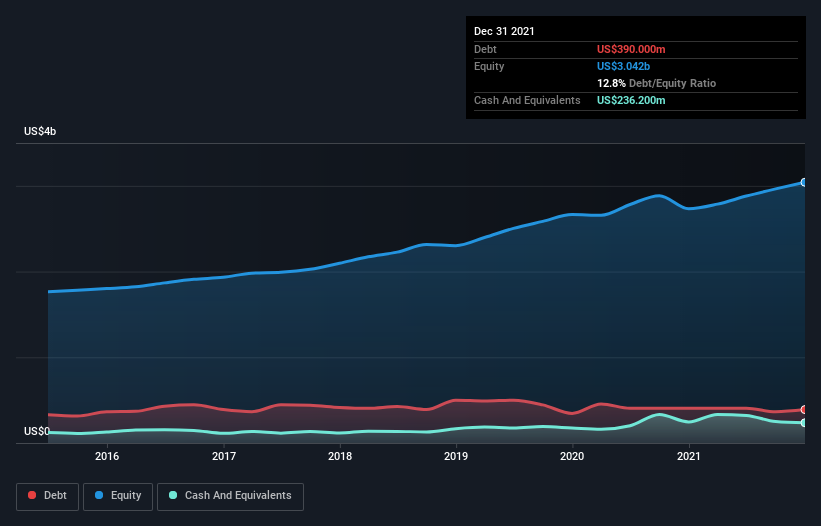- United States
- /
- Trade Distributors
- /
- NasdaqGS:FAST
Fastenal (NASDAQ:FAST) Has A Pretty Healthy Balance Sheet

Some say volatility, rather than debt, is the best way to think about risk as an investor, but Warren Buffett famously said that 'Volatility is far from synonymous with risk.' So it might be obvious that you need to consider debt, when you think about how risky any given stock is, because too much debt can sink a company. Importantly, Fastenal Company (NASDAQ:FAST) does carry debt. But should shareholders be worried about its use of debt?
What Risk Does Debt Bring?
Generally speaking, debt only becomes a real problem when a company can't easily pay it off, either by raising capital or with its own cash flow. Part and parcel of capitalism is the process of 'creative destruction' where failed businesses are mercilessly liquidated by their bankers. While that is not too common, we often do see indebted companies permanently diluting shareholders because lenders force them to raise capital at a distressed price. Of course, plenty of companies use debt to fund growth, without any negative consequences. When we think about a company's use of debt, we first look at cash and debt together.
Check out our latest analysis for Fastenal
How Much Debt Does Fastenal Carry?
The chart below, which you can click on for greater detail, shows that Fastenal had US$390.0m in debt in December 2021; about the same as the year before. However, it does have US$236.2m in cash offsetting this, leading to net debt of about US$153.8m.

A Look At Fastenal's Liabilities
Zooming in on the latest balance sheet data, we can see that Fastenal had liabilities of US$682.2m due within 12 months and liabilities of US$574.6m due beyond that. On the other hand, it had cash of US$236.2m and US$900.2m worth of receivables due within a year. So its liabilities total US$120.4m more than the combination of its cash and short-term receivables.
Having regard to Fastenal's size, it seems that its liquid assets are well balanced with its total liabilities. So while it's hard to imagine that the US$33.8b company is struggling for cash, we still think it's worth monitoring its balance sheet. Carrying virtually no net debt, Fastenal has a very light debt load indeed.
In order to size up a company's debt relative to its earnings, we calculate its net debt divided by its earnings before interest, tax, depreciation, and amortization (EBITDA) and its earnings before interest and tax (EBIT) divided by its interest expense (its interest cover). This way, we consider both the absolute quantum of the debt, as well as the interest rates paid on it.
Fastenal's net debt is only 0.11 times its EBITDA. And its EBIT covers its interest expense a whopping 127 times over. So we're pretty relaxed about its super-conservative use of debt. The good news is that Fastenal has increased its EBIT by 6.6% over twelve months, which should ease any concerns about debt repayment. The balance sheet is clearly the area to focus on when you are analysing debt. But ultimately the future profitability of the business will decide if Fastenal can strengthen its balance sheet over time. So if you want to see what the professionals think, you might find this free report on analyst profit forecasts to be interesting.
Finally, a company can only pay off debt with cold hard cash, not accounting profits. So we always check how much of that EBIT is translated into free cash flow. During the last three years, Fastenal produced sturdy free cash flow equating to 63% of its EBIT, about what we'd expect. This free cash flow puts the company in a good position to pay down debt, when appropriate.
Our View
Happily, Fastenal's impressive interest cover implies it has the upper hand on its debt. And that's just the beginning of the good news since its net debt to EBITDA is also very heartening. Zooming out, Fastenal seems to use debt quite reasonably; and that gets the nod from us. While debt does bring risk, when used wisely it can also bring a higher return on equity. There's no doubt that we learn most about debt from the balance sheet. However, not all investment risk resides within the balance sheet - far from it. For example, we've discovered 1 warning sign for Fastenal that you should be aware of before investing here.
Of course, if you're the type of investor who prefers buying stocks without the burden of debt, then don't hesitate to discover our exclusive list of net cash growth stocks, today.
New: AI Stock Screener & Alerts
Our new AI Stock Screener scans the market every day to uncover opportunities.
• Dividend Powerhouses (3%+ Yield)
• Undervalued Small Caps with Insider Buying
• High growth Tech and AI Companies
Or build your own from over 50 metrics.
Have feedback on this article? Concerned about the content? Get in touch with us directly. Alternatively, email editorial-team (at) simplywallst.com.
This article by Simply Wall St is general in nature. We provide commentary based on historical data and analyst forecasts only using an unbiased methodology and our articles are not intended to be financial advice. It does not constitute a recommendation to buy or sell any stock, and does not take account of your objectives, or your financial situation. We aim to bring you long-term focused analysis driven by fundamental data. Note that our analysis may not factor in the latest price-sensitive company announcements or qualitative material. Simply Wall St has no position in any stocks mentioned.
About NasdaqGS:FAST
Fastenal
Engages in the wholesale distribution of industrial and construction supplies in the United States, Canada, Mexico, and internationally.
Flawless balance sheet average dividend payer.
Similar Companies
Market Insights
Community Narratives



